General-Purpose Ø50 mm Integrating Spheres
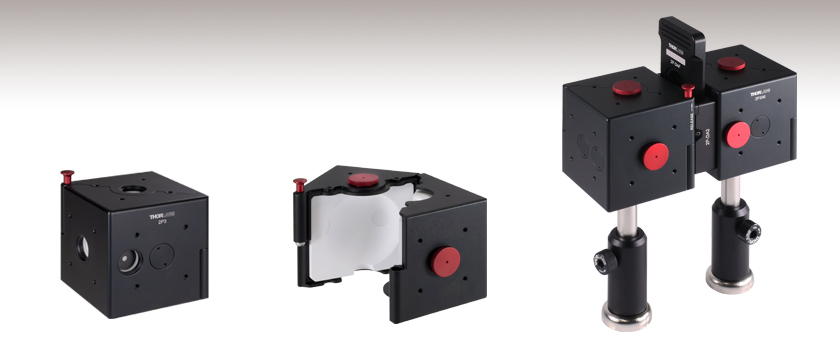
- Made of Durable, Highly Reflective Bulk Material
- 3 or 4 Input Ports and 1 Detector (Output) Port
- SM05 Threading and 30 mm Cage System Compatibility
- Post Mountable (Imperial and Metric Versions)
Application Idea
2P-DA2 Dovetail Adapter with Filter Holder Creates a Light-Tight Connection Between Two 2P3 Integrating Spheres
2P3
3 Input Ports
Highly Reflective Interior over 250 - 2500 nm

Please Wait
| Compatible Mounted Photodiodes | ||
|---|---|---|
| Sensor Type | Wavelength Range | Photodiodes |
| Si | 200 - 1100 nm | SM05PD2A SM05PD2B |
| Si | 350 - 1100 nm | SM05PD1A SM05PD1B |
| InGaAs | 800 - 1700 nm | SM05PD5A |
| 900 - 1700 nm | SM05PD4A | |
| Ge | 800 - 1800 nm | SM05PD6A |
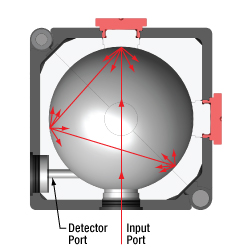
Click to Enlarge
Figure 1.2 Integrating Sphere Interior
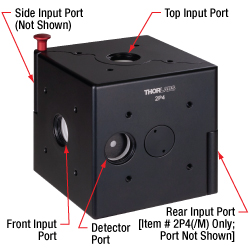
Click to Enlarge
Figure 1.1 Layout of Ports on Integrating Sphere Housing
Features
- Ø50 mm Integrating Spheres in Black Anodized Aluminum Housings
- Durable, White, High-Reflectance Sphere Material for 250 - 2500 nm
- Equipped with Three or Four SM05 (0.535"-40) Threaded Input Ports for Easy Coupling of Light
- Recessed Ø3 mm Detector Port with SM05 Threading Allows Direct Connection of Any of Our SM05PD Series Photodiodes
- Directly Compatible with SM05 Lens Tubes and Our 30 mm Cage Systems
- Imperial and Metric Versions for Post Mounting
- Slim and Filter Holder Dovetail Adapters Available to Create Light-Tight Connection Between Spheres
- FC/PC, SMA, and Ferrule Adapters for Integrating Sphere Ports Available
Thorlabs' Integrating Spheres are general-purpose devices for high sensitivity measurements of optical signals. An integrating sphere evenly spreads the incoming light by multiple reflections over the entire sphere surface. This makes it the ideal instrument for many applications such as laser power, flux, reflectance, and radiance measurements.
The input ports and detector ports feature internal SM05 (0.535"-40) threading, allowing them to be equipped with a variety of accessories. Reflective-coated port plugs and fiber adapters are available below for use with the input ports. The detector port is compatible with our SM05PD series photodiodes. Other externally SM05-threaded accessories, such as our lens tube systems, can be connected directly to the integrating sphere ports. Additionally, the detector port is recessed to avoid directly exposing the active area of the photodiode to the incident light.
Each face of the integrating sphere has 4-40 taps spaced for compatibility with Thorlabs 30 mm cage systems or the dovetail adapters available below. The dovetail adapters are useful where light-tight connections between multiple integrating spheres are needed to provide increased diffusion of light for high sensitivity applications such as those involving single photon detectors. The base of each unit features an 8-32 (M4) threaded hole for post mounting.
The sphere is manufactured from PTFE-based bulk material that has high reflectance in the 250 - 2500 nm wavelength range (see the Specs tab for details) and is resistant to heat, humidity, and high levels of radiation. This reflective surface provides a specific roughness and diffusive reflection properties. It should not be cleaned using solvents, as this could damage the inner surface. We only recommend using compressed air for cleaning the inner surface of the integrating spheres (Item #s CA4-US and CA6-EU).
Thorlabs can calibrate integrating spheres with user-selected sensors upon request and provide the pertinent NIST- and/or PTB-traceable certificates of calibration. Contact Tech Support for more information.
We also offer modular integrating spheres that can be configured with a variety of housing interfaces for compatibility with different optomechanical systems.
| Item # | 2P3(/M) | 2P4(/M) |
|---|---|---|
| Input Ports | Three: Front, Side, and Top | Four: Front, Side, Rear, and Top |
| Sphere Diameter | 50 mm | |
| Input Port Diameter | 11.5 mm (0.45") | |
| Detector Port | Ø3 mm with SM05 (0.535"-40) Thread | |
| Typical Reflectance | >94% at 250 nm - 2500 nm ~99% at 350 nm - 1500 nm |
|
| Wavelength Range | 250 nm - 2500 nm | |
| Operating Temperature | -20 °C to 60 °C | |
| Operating Humidity | 5% to 95% | |
| Laser Damage Threshold | Pulsed: 7 J/cm2 CW: 2 kW/cm2 |
|
| Weight | 350 g | |
| Dimensions | 63.0 mm x 63.0 mm x 77.0 mm (2.48" x 2.48" x 3.03") |
|
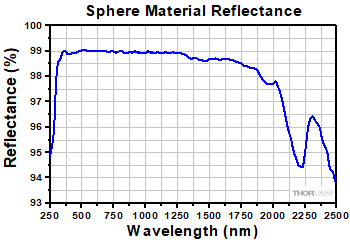
Click to Enlarge
Figure 2.1 Integrating Sphere Material Reflectance
Insights into Best Lab Practices
Scroll down to read about things to consider when building integrating spheres into setups and analyzing data results.
- Ultraviolet and Blue Fluorescence Emitted by Integrating Spheres
- Sample Substitution Errors
Click here for more insights into lab practices and equipment.
Ultraviolet and Blue Fluorescence Emitted by Integrating Spheres
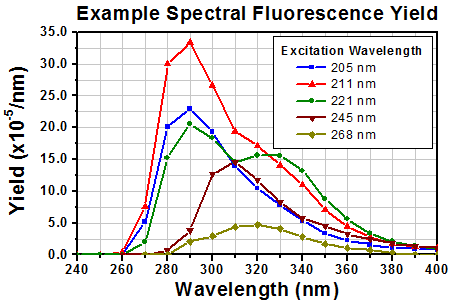
Click to Enlarge
Figure 182A Typical yields at each wavelength are around four orders of magnitude lower than the excitation wavelength. [4]
The spectral fluorescence yield relates the intensity of the fluorescence emitted within the integrating sphere with the intensity of the excitation wavelength. The yield is calculated by dividing the wavelength-dependent, total fluorescence excited over the entire interior surface of the sphere by the intensity of the light excitation.
Data were kindly provided by Dr. Ping-Shine Shaw, Physics Laboratory, National Institute of Standards and Technology, Gaithersburg, MD 20899, USA.
A material of choice for coating the light-diffusing cavities of integrating spheres is polytetrafluoroethylene (PTFE). This material, which is white in appearance, is favored for reasons including its high, flat reflectance over a wide range of wavelengths (see the Specs tab for details) and chemical inertness.
However, it should be noted that integrating spheres coated with both PTFE and barium sulfate, which is an alternative coating with lower reflectance, emit low levels of ultraviolet (UV) and blue fluorescence when irradiated by UV light. [1-3]
Hydrocarbons in the PTFE Fluoresce
It is not the PTFE that fluoresces. The sources of the UV and blue fluorescence are hydrocarbons in the PTFE. Low levels of hydrocarbon impurities are present in the raw coating material, and pollution sources deposit additional hydrocarbon contaminants in the PTFE material of the integrating sphere during its use and
Fluorescence Wavelength Bands and Strength
Researchers at the National Institute of Standards and Technology (NIST) have investigated the fluorescence excited by illuminating PTFE-coated integrating spheres. The total fluorescence output by the integrating sphere was measured with respect to fluorescence wavelength and excitation wavelength. The maximum fluorescence was approximately four orders of magnitude lower than the intensity of the exciting radiation.
The UV and blue fluorescence from PTFE is primarily excited by incident wavelengths in a 200 nm to 300 nm absorption band. The fluorescence is emitted in the 250 nm to 400 nm wavelength range, as shown by Figure 182A. These data indicate that increasing the excitation wavelength decreases the fluorescence emitted at lower wavelengths and changes the shape of the fluorescence spectrum.
As the levels of hydrocarbon contaminants in the PFTE increase, fluorescence increases. A related effect is a decrease of the light output by the integrating sphere over the absorption band wavelengths, due to more light from this spectral region being absorbed. [1, 3]
Impact on Applications
The UV and blue fluorescence from the PTFE has negligible effect on many applications, since the intensity of the fluorescence is low and primarily excited by incident wavelengths <300 nm. Applications sensitive to this fluorescence include long-term measurements of UV radiation throughput, UV source calibration, establishing UV reflectance standards, and performing some UV remote sensing tasks. [1]
Minimizing Fluorescence Effects
Minimizing and stabilizing the fluorescence levels requires isolating the integrating sphere from all sources of hydrocarbons, including gasoline- and diesel-burning engine exhaust and organic solvents, such as naphthalene and toluene. It should be noted that, while hydrocarbon contamination can be minimized and reduced, it cannot be eliminated. [1]
Since the history of each integrating sphere's exposure to hydrocarbon contaminants is unique, it is not possible to predict the response of a particular sphere to incident radiation. When an application is negatively impacted by the fluorescence, calibration of the integrating sphere is recommended. A calibration procedure described in [4] requires a light source with a well-known spectrum that extends across the wavelength region of interest, such as a deuterium lamp or synchrotron radiation, a monochromator, a detector, and the integrating sphere.
References
[1] Ping-Shine Shaw, Zhigang Li, Uwe Arp, and Keith R. Lykke, "Ultraviolet characterization of integrating spheres," Appl.Opt. 46, 5119-5128 (2007).
[2] Jan Valenta, "Photoluminescence of the integrating sphere walls, its influence on the absolute quantum yield measurements and correction methods," AIP Advances 8, 102123 (2018).
[3] Robert D. Saunders and William R. Ott, "Spectral irradiance measurements: effect of UV-produced fluorescence in integrating spheres," Appl. Opt. 15, 827-828 (1976).
[4] Ping-Shine Shaw, Uwe Arp, and Keith R. Lykke, "Measurement of the ultraviolet-induced fluorescence yield from integrating spheres," Metrologia 46, S191 - S196 (2009).
Date of Last Edit: Dec. 4, 2019
Sample Substitution Errors

Click to Enlarge
Figure 182B Measuring diffuse sample transmittance and reflectance as shown here can result in a distorted sample spectrum due to sample substitution error. The problem is that the reflectivity over the sample area is different during the reference and sample measurements.
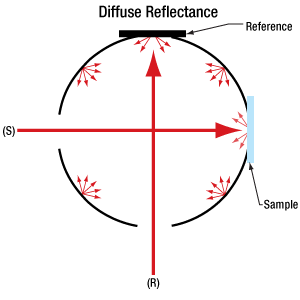
Click to Enlarge
Figure 182C This configuration is not susceptible to sample substitution error, since the interior of the sphere is the same for reference and sample measurements. During the reference measurement the light travels along (R), and no light is incident along (S). The opposite is true when a sample measurement is made.
Absolute transmittance and absolute diffuse reflectance spectra of optical samples can be found using integrating spheres. These spectra are found by performing spectral measurements of both the sample of interest and a reference.
Measurement of a reference is needed since this provides the spectrum of the illuminating light source. Obtaining the reference scan allows the spectrum of the light source to be subtracted from the sample measurement.
The light source reference measurement is made with no sample in place for transmittance data and with a highly reflective white standard reference sample in place for reflectance measurements.
Sample substitution errors incurred while acquiring the sample and reference measurement sets can negatively effect the accuracy of the corrected sample spectrum, unless the chosen experimental technique is immune to these errors.
Conditions Leading to Sample Substitution Errors
An integrating sphere's optical performance depends on the reflectance at each point on its entire inner surface. Often, a section of the sphere's inner wall is replaced by the sample when its transmittance and diffuse reflectance spectra are measured (Figure 182B). However, modifying a section of the inner wall alters the performance of the integrating sphere.
Sample substitution errors are a concern when the measurement procedure involves physically changing one sample installed within the sphere for another. For example, when measuring diffuse reflectance (Figure 182B, bottom), a first measurement might be made with the standard reference sample mounted inside the sphere. Next, this sample would be removed and replaced by the sample of interest, and a second measurement would be acquired. Both data sets would then be used to calculate the corrected absolute diffuse reflectance spectrum of the sample.
This procedure would result in a distorted absolute sample spectrum. Since the sample of interest and the standard reference have different absorption and scattering properties, exchanging them alters the reflectivity of the integrating sphere over the samples' surface areas. Due to the average reflectivity of the integrating sphere being different for the two measurements, they are not perfectly compatible.
Solution Option: Install Sample and Reference Together
One experimental technique that avoids sample substitution errors acquires measurement data when both sample and reference are installed inside the integrating sphere at the same time. This approach requires an integrating sphere large enough to accomodate the two, as additional ports.
The light source is located external to the integrating sphere, and measurements of the sample and standard reference are acquired sequentially. The specular reflection from the sample, or the transmitted beam, is often routed out of the sphere, so that only the diffuse light is detected. Since the inner surface of the sphere is identical for both measurements, sample substitution errors are not a concern.
Alternate Solution Option: Make Measurements from Sample and Reference Ports
If it is not possible to install both sample and standard references in the integrating sphere at the same time, it is necessary to exchange the installed sample. If this must be done, sample substitution errors can be removed by following the procedure detailed in [1].
This procedure requires a total of four measurements. When the standard sample is installed, measurements are made from two different ports. One has a field of view that includes the sample and the other does not. The sample of interest is then subsituted in and the measurements are repeated. Performing the calculations described in [1] using these measurements removes the sample substitution errors.
References
[1] Luka Vidovic and Boris Majaron, "Elimination of single-beam substitution error in diffuse reflectance measurements using an integrating sphere," J. Biomed.Opt. 19, 027006 (2014).
Date of Last Edit: Dec. 4, 2019
| Posted Comments: | |
Jan Schröter
(posted 2025-07-09 06:04:16.78) Hello, I'm trying to use the sphere to measure power while having aditional ports for spectrum etc.
I'd like to use a Power Meter Interface PM101. Which sensor would you recommend? hchow
(posted 2025-07-10 05:08:47.0) Dear Mr. Schröter, thank you for your feedback. We actually offer specials where you can pick and choose a suitable SM05-threaded mounted photodiode of your choice, after which, we calibrate the 2P3/4 together with the photodiode. We will then add a SMA to D-Sub 9 connector where the calibration data is stored on a EEPROM chip in the connector. You can then use this special with any of our power meter consoles/interfaces. In any case, I will personally reach out to you to provide solutions. user
(posted 2024-10-22 10:00:52.953) Hello! We would like to use the integrating sphere as a uniform light source for a mobile camera characterization. Our camera sensor is around 8-9 mm diameter. Could some accessories be used to add to the detector port of the sphere? Thanks! hchow
(posted 2024-10-23 05:21:56.0) Dear User, thank you for your feedback. I will personally reach out to you to provide viable solutions. Thank you. user
(posted 2024-03-15 08:31:50.59) Could these integrating spheres be used for illumination? We would like to use the 2P4 to create a uniform light source for camera sensor characterization. dpossin
(posted 2024-03-18 03:12:35.0) Dear Frank,
Thank you for your feedback. Yes the integrating spheres can be used for creating uniform light sources. Please note that the multiple inner reflections leads to attenuation of the output signal. The attenuation can be roughly estimated by calculating the ratio between the inner sphere area and the area of the output aperture. I am reaching out to you in order to provide further support. James Casey
(posted 2024-02-21 10:44:06.077) Is there a way to order two 8-32 tapped mounting plugs for the 2P4 integrating sphere? The plug I currently have has stripped threads, so I would like to get two replacements.
Thank you,
James Casey
Dow Chemical
james.casey@dow.com fmortaheb
(posted 2024-02-23 06:36:51.0) Thank you very much for contacting us. We can offer you the replacement. We'll reach out to you directly to provide you with a quote. Huiqin Zhang
(posted 2024-01-23 17:40:23.0) Hi, I am currently using reflectance mode in 2P4/M. Is there a way or any adapter to put the sample closer to the inner sphere? My sample is a large whiteboard and cannot be placed inside the sphere. However, when putting it outside of the outter sphere, there is a lot of reflected and scattered power lost at the thickness of the sphere and the measurement is inaccurate. Is there any recommended setups? Thanks. hkarpenko
(posted 2024-01-30 11:29:42.0) Dear Huiqin,
thank you for your feedback. The available adapters we currently offer, can be seen on the webpage. To select the suitable one for your application and discuss your application in detail, I will contact you directly. Robert Hlavac
(posted 2023-09-08 11:02:20.51) Hello,
Is there any way to clean the inside of the sphere without damaging it? In the description it is written not to use solvents only compressed air, but during my measurements some degradation of sample may have caused some adsorption on the inside of the sphere, and i dont think compressed air will be sufficient. Is there any other way ?
Thank you
Robert hchow
(posted 2023-09-08 09:16:16.0) Dear Mr. Hlavac, thank you for the feedback. Depending on the severity of the spill inside the integrating sphere, the performance of the integrating sphere might not be optimal. That being said, if you have spilled some solvent inside the sphere and it stains the sides, there isn't much else we can do. Wiping the internal cavity of the sphere with any inorganic solvent will most likely damage the sensitive white polymer coating even further. In any case, I will personally reach out to you to see how we can solve this problem for you. Thank you. Aparajita Naik
(posted 2023-06-27 11:30:43.7) Hi,
Is there a way to use the 2P3 integrating sphere in reflectance mode. Also from drawings I understand that there is distance of about 6mm. Will placement of samples outside the sphere affect the accuracy. hchow
(posted 2023-06-29 11:15:20.0) Dear Mr. Naik, thank you for your feedback. The 2P3 integrating sphere can indeed be used in reflectance mode. The distance between the inner round cavity of the sphere to the outer surface of the cube shape of the product is roughly 3.5 mm. The samples should be placed as near as possible to one of the ports of the sphere in order to guarantee the reflected light from the sample is kept within integrating sphere. user
(posted 2023-02-22 16:51:00.04) Hi, what is the name of the high reflectivity coating on these integrating spheres, is it Spectraflect? hchow
(posted 2023-02-23 06:44:08.0) Dear Customer, the internal coating within the cavity of the integrating sphere is made from PTFE or Polytetrafluoroethylene. Taras Lisouski
(posted 2022-10-04 17:27:50.663) Hello,
The drawings presented in the Tab "Insights" show that the samples are placed extremely close to the circumference of the integrating sphere, almost on the inner surface of the sphere. At the same time, it looks that the sample is bigger than the port opening. We understand that this is a schematic drawing. Below are our questions:
1. How can the sample be placed this way in practice? In case for 1" or 1/2" flat sample, for example.
2. We understand that the distance between the inner circumference of the sphere and the external surface of the port is about 6 mm. Will this distance influence the accuracy of measurements? dpossin
(posted 2022-10-05 08:26:23.0) Dear Taras,
Thank you for your feedback. The 2P4 can be opened completely in order to place an sample inside. Regarding your other question I reach out to you directly. Rommel Ignacio
(posted 2022-08-11 15:44:29.147) may we know what is the replacement for IS200-4 Sphere? Kindly send us a quote for 3pcs. T hkarpenko
(posted 2022-08-11 11:13:33.0) Dear Rommel,
thank you very much for your feedback. We have no direct replacement for the IS200-4, since we have changed the design for our integrating spheres. The most similar sphere is the 2p4 with 4 ports.
I will contact you directly to discuss this with you further. user
(posted 2021-12-03 02:05:31.143) Hi, I want to combine light pulses emitted from several (2-3) Xe-sources into one optical fiber. Can integrating spheres such as 2P3 be used in this kind of application ? Best regards, Jukka mdiekmann
(posted 2021-12-07 11:07:44.0) Hello - Thank you for your interest in this product. We will contact you directly to discuss your applciation. Ermanno Bernasconi
(posted 2021-07-14 10:21:55.28) Good MKiess
(posted 2021-07-16 11:05:41.0) Dear Ermanno, Thank you very much for this feedback. We are glad that you like our product. It is always nice to hear when you are satisfied with the quality and application of our products. Thank you very much thomas pongetti
(posted 2021-05-25 12:19:55.72) Do you carry or customize gold integrating spheres that operate from 6 to 10 micrometers? soswald
(posted 2021-05-28 05:16:09.0) Dear Thomas,
thank you for your feedback. Gold-coated integrating spheres are currently not part of our catalogue, but we plan to add them in the future, hopefully next year.
For a short term solution we could offer an uncalibrated VML10T0 added to S180C to measure the spectral range from 6 to 10 microns.
Since you prefer not to be contacted, please contact your local tech support team for further information. Huabin Yu
(posted 2020-11-11 13:13:34.023) I notice that there are sphere material reflectance profiles of the Integrating sphere (IS200-4) above 250 nm. However, I want to know the sphere material reflectance between 230nm to 250 nm. wskopalik
(posted 2020-11-11 10:31:54.0) Dear Huabin,
Thank you very much for your inquiry.
Unfortunately we have no data showing the reflectivity below 250nm. At 250nm the reflectivity has already dropped to about 95%. For shorter wavelengths the reflectivity of the sintered PTFE material will drop even further.
I will contact you directly to discuss your application in more detail. Paweł Hermanowicz
(posted 2020-10-21 08:47:13.48) I have received a IS236A-4 sphere with a mounted photodiode detector stuck inside the SM05 tube. When I tried to remove it, the photodiode did not yield, instead its leg broke or at least deatached form the SMA connector, so that it no longer works. Thorlabs declined to replace it. dpossin
(posted 2020-10-23 08:35:13.0) Dear Pawel, Thank you very much for your feedback. Sorry for the inconvenience this has caused you. We would be happy to repair your integrating sphere. I will reach out to you in order to find an agreeable solution. Szymon Grzanka
(posted 2020-10-20 13:14:38.587) Hello,
I would like to buy an integrating sphere with four ports and a mounted photodiode. I don't know what device (power meter) can be connected to the photodiode to be able to measure optical power. One of the remaining ports will have an optical fiber installed and a spectrometer will be connected to it. The whole is to measure the LIV characteristics.
Thank you in advance for your help.
Best wishes,
Szymon Grzanka dpossin
(posted 2020-10-21 10:26:20.0) Dear Szymon, Thank you for your feedback. I am reaching out to you in order to discuss available options with you. user
(posted 2019-12-16 15:52:36.14) Hi,
I'm interested in purchasing a IS210C that is calibrated. It says on the site: "For our integrating spheres we offer a calibration service upon request."
What does this calibration involve? Ideally, I'd like to get a power reading into Matlab or Labview while using other ports for a Spec Analyzer. Do I need other accessories for a digital power reading?
Would the link below with S145C integrating sphere be a better alternative? I'd lose the extra ports.
https://www.thorlabs.com/newgrouppage9.cfm?objectgroup_id=4688
Thanks,
-Ashok nreusch
(posted 2019-12-18 07:22:14.0) This is a response from Nicola at Thorlabs. Thank you for your inquiry. We can offer a calibrated version of our integrating spheres. Before calibrating the sphere, we need to check which port configuration you would like to use. During the calibration, we determine the wavelength-dependent responsivity of the photodiode. The photodiode will deliver a photocurrent and the optical power needs to be recalculated based on the calibrated responsivity data. In order to be able to directly use the power reading in terms of Watts in Matlab or Labview, you need to implement the responsivity data into your program code. As alternative, we can also offer a customization in which the photodiode is read out via our C-type connector similar to S145C. You can then use a powermeter console like e.g. PM100USB to convert and read out the optical power in Watts in Matlab or Labview. I will contact you directly to discuss your port configuration and send you a quotation. user
(posted 2019-12-13 06:11:48.157) Dear Thorlabs Team,
I would like to purchase an integrating sphere. At now, I just need three ports, but in the future, I may need the fourth. I would like to ask about the drawbacks of the fourth port in the 2 inches integrating sphere. Have you noticed any significant drop in the attenuation level of the sphere?
Best regards,
Pawel Hermanowicz
Jagiellonian University,
Krakow, Poland MKiess
(posted 2019-12-13 08:23:03.0) This is a response from Michael at Thorlabs. Thank you very much for your inquiry! You can use an Integrated Sphere with four ports (like IS200-4) and close the unused port with an SM05CP2C end cap. This end cap has the same surface as the integrating sphere itself. If you want to use the port after all, you can simply unscrew the SM05CP2C.
If you use the Sphere correctly and prevent dirt from getting inside, you should not notice any major changes in the reflectivity of the surface. A diode itself, on the other hand, should be calibrated annually. Even if you change the input ports, you should recalibrate them due to the changed circumstances. Felix Köttig
(posted 2019-09-27 08:46:08.167) Dear Thorlabs support,
I was wondering if you can provide the reflectivity curve of the integrating sphere coating down to 200 nm?
Thanks and best regards,
Felix Köttig
Max Planck Institute for the Science of Light
Erlangen, Germany wskopalik
(posted 2019-10-04 11:08:16.0) This is a response from Wolfgang at Thorlabs. Thank you very much for your inquiry.
Unfortunately we have no data showing the reflectivity below 250nm. At 250nm the reflectivity has already dropped down to 95%. For shorter wavelengths the reflectivity of the sintered PTFE material will drop even further.
I will contact you directly to discuss your application in more detail. Bill Albert
(posted 2019-07-02 19:00:44.777) I am curious why the effective loss of the integrating sphere is not included in the specifications. If the Integrating Sphere has an effective power loss of 20dB between the input and output ports, the measuring sensor system has lost an effective 20dB of sensitivity. For a sphere with 30dB of loss, the effect is, of course, correspondingly greater. From a systems standpoint, I believe the information would be most helpful for determining the required sensor to mate the sphere with. MKiess
(posted 2019-07-08 10:02:51.0) This is a response from Michael at Thorlabs. Thank you very much for inquiry.
The effective loss depends on various factors, such as the wavelength of the light, the area of the sensor, and the ports which are used. The theoretical attenuation can be calculated with the wavelength-dependent reflection of the PTFE surface, as shown in the specifications on the webpage. With these values, the sphere surface of approximately 8100mm^2 and the aperture of the outputs, the attenuation can be estimated. In addition there is a gain factor of 1.5 due to multiple reflections, which can be neglected again due to special sphere properties resulting from manufacturing. We also offer models incl. calibration service and desired sensor. I have contacted you directly to select a suitable sensor for your application and provide further assistance. benjamin.bissig
(posted 2018-01-18 15:52:36.673) Hi. Do you offer a solution to introduce (thin film on substrate) samples into the sphere? wskopalik
(posted 2018-01-19 04:44:26.0) This is a response from Wolfgang at Thorlabs. Thank you very much for your inquiry.
We don't offer a ready-to-use solution for this. The integrating spheres have however a lot of possibilities to attach mounts. You could e.g. use the SM05 threading in the ports or also the 4-40 threads which are normally used for our cage sytem.
It is important to note that the reflecting surface on the inside of the sphere must not be touched by the sample because this could change the reflectivity of the surface.
I will contact you directly to provide further assistance. hsubon
(posted 2017-05-23 20:23:18.117) The listed two InGaAs detectors for the integrating sphere IS210C, SM05PD4A and SM05PD5A, are both shown "Cathode-grounded". However, in "Speccs", IS210C shows "Anode-Grounded SM05PD4A". Please clarify which description is correct. Thanks. wskopalik
(posted 2017-05-24 11:32:18.0) This is a response from Wolfgang at Thorlabs. Thank you very much for your inquiry.
The SM05PD4A and SM05PD5A are both cathode grounded and they can both be attached to the integrating sphere IS200.
The IS210C is a bundle of an integrating sphere IS200 and an InGaAs photodiode. The photodiode in this bundle is a special anode grounded version of the SM05PD4A which used to be available as a catalog item and can now be offered as a special. It was called SM05PD4B. The housing and the photodiode in SM05PD4A and SM05PD4B are the same, only the grounding is different.
I will contact you directly to provide further assistance. huke
(posted 2016-06-13 15:32:21.163) I would like to get an estimate for the efficiency (incoupled light intensity/ outcoupled light intensity) of incoherent light for the full specified wavelength range at all ports. Is this possible? shallwig
(posted 2016-06-15 06:29:41.0) This is a response from Stefan at Thorlabs. Thank you for your inquiry. The theoretical attenuation level can be calculated from the reflection of the PTFE, the reflectivity graph can be found in the “specs” Tab, from the sphere surface which is ca. 8100mm2 and the area of the aperture light gets coupled out. The attenuation factor calculated this way allows you to estimate the efficiency. But due to some sphere specific properties (bulky parts of the sphere, joints, ports) this must be decreased by a factor of about 1.5. I have called you to discuss your application in more detail and check if a special meets your requirements. emtonita
(posted 2015-03-30 14:08:51.517) Hello! I was wondering: what is the performance of the IS200 at 180nm? I understand the sphere is supposed to work in the range of 250-2500nm at ~99% reflectivity. What is it's reflectivity at 180nm? Thank you, Erin. shallwig
(posted 2015-03-31 03:24:32.0) This is a response from Stefan at Thorlabs. Thank you very much for your inquiry. Unfortunately we have no data showing the reflectivity below 250nm . In the “Specs” Tab of the website http://www.thorlabs.de/newgrouppage9.cfm?objectgroup_id=1658&pn=IS200#6613 you can find the reflectivity plot. At 250nm the reflectivity drops down to 95% and for shorter wavelength the reflectivity of the used sintered PTFE will be less. The integrating spheres show significant absorption and fluorescence features for UV light. Any environmental contaminants strengthen this behavior. These features are more pronounced for sintered integrating spheres than pressed ones. There is no special coating for UV available.
I will contact you directly to discuss your application in more detail. patricio_romero
(posted 2015-03-17 17:29:39.497) Hello
I have a IS200-4 Sphere. In one of the caps, when i unscrew it, the Coating part stay inside the sphere, and I only get out the metal cap with the glue (souble contact) on it.
Reading the description I see that the coating is PTFE, so:
- Would the reflective part whistand forces to remove it?
- Once I remove it, would it whistand pressing it with a finger against the metal cap so it glues completely on the metal cap? (seems like only the borders make contact).
- Would a piece of parafilm work as protection to press it with my finger or it would contaminate it? If so, what should be "clean enough" to push against the reflective part to fix it in the metal cap? shallwig
(posted 2015-03-18 10:09:42.0) This is a response from Stefan at Thorlabs. Thank you very much for your inquiry and please apologize the problems you face with one of the caps of your IS200-4 integrating sphere. This should not happen that the coating part stays inside the sphere when unscrewing the cap. I will contact you directly and we will send you an exchange of the End cap (SM05CP2C). I am sorry for any inconveniences. michael-miller
(posted 2015-02-23 18:32:41.9) We have purchased an IS200-4 integrating sphere. Our application is under vacuum. If we were to partially evacuate the interior of the sphere, would we compromise the integrity of the sphere?
Thanks tschalk
(posted 2015-02-25 09:06:58.0) This is a response from Thomas at Thorlabs. Thank you very much for your inquiry. Our integrating spheres are not designed to be used in vacuum. The housing is anodized which will have a bad influence of the vacuum quality. Otherwise, there is no fundamental reason why the unit shouldn’t work in vacuum conditions. I will contact you directly to discuss your application. 1982ariel
(posted 2015-01-21 15:51:41.24) Thorlabs hello
I think that it would be better to present 3D images option of the products. The kind where you can rotate the product.
Some times I need to know if there is a thread or some other standard feature.
Ariel myanakas
(posted 2015-01-21 11:26:02.0) Response from Mike at Thorlabs: Thank you for your feedback. We will look into the possibility of adding a feature like this in the future. However, The taps, threading, and other design elements of a product can be found in the PDF drawing which can be found by clicking on the red "Docs" icon by the blue item number links. We also offer models that can be viewed and rotated by clicking on the available model files (Step, Solidworks, e-drawing) within the same "Docs" link. parispapagiorgis
(posted 2014-05-09 13:24:24.853) I would like to ask, how to clean the inner surface of the sphere, from traces of samples meausered? Are there any solvents or other ways to clean it? shallwig
(posted 2014-05-12 05:13:39.0) This is a response from Stefan at Thorlabs. Thank you very much for your inquiry. We only recommend to use air for cleaning the inner surfaces of the integrating spheres. The inner surface is made from specially sintered PTFE which provides its particular roughness and the diffusive reflection properties. Buy cleaning the surface with any solvents it is possible that the roughness get damaged hence the properties of the reflection change. If your application does not require the calibration to be maintained, then other cleaning methods would also work. I will contact you directly to discuss a solution for your application in detail. user
(posted 2013-05-03 15:47:14.22) An integrating sphere as the IS200 or the IS200-4 with 2 detector ports would be useful for applications where different dectors are required. Im my case, I need the same detector, but with different filters in front of it. Removing the dector and changing the filter is not convenient... Others applications where an infrared and visible detector could be used at the same time are also possible. tschalk
(posted 2013-05-06 11:12:00.0) This is a response from Thomas at Thorlabs. Thank you very much for your feedback. It is a very good idea to have one more port for an additional detector. I will forward this idea to our development department. tschalk
(posted 2013-05-08 01:54:00.0) This is a response from Thomas at Thorlabs. I discussed this idea with our development department and we can offer a special item. It would be great if you can contact us (Europe@thorlabs.com) to discuss your application and the details for the special. segreto
(posted 2013-04-02 15:42:27.423) The SMA Fiber Adapter Plate should be coated with the Reflective Sphere Material. cdaly
(posted 2013-04-04 10:10:00.0) Response from Chris at Thorlabs: Thank you for using the web feedback. The fiber adapter, SM05SMA, is used outside of the IS200(-4) as well, which is why it's not covered with PTFE already. We may be able to offer this as a custom and I will contact you directly to speak about this. Since you will need to calibrate the photodiode mounted in the IS200-4, this uncoated area should not affect your measurement. tschalk
(posted 2012-10-24 12:34:00.0) Response from Thomas at Thorlabs:
Thank you very much for your inquiry. The reflectance of the sphere material is wavelength dependent and about 99% from 350nm to 1500nm. The lose is caused by the reflections inside the sphere. Unfortunately there is nothing you can do against it because this is a physical characteristic of the reflectance material.
I will contact you directly to discuss this issue. a.d.v.dam
(posted 2012-10-24 06:01:24.747) The intensity of the light entering the sphere is about 10x as much as the light which comes out at the detector port. It seems that we lose 90% of the light inside the sphere, probably absorbed by the white coating. Is this possible? What can we do to actually collect all the light in the sphere?
Thanks. jvigroux
(posted 2012-10-03 08:08:00.0) A response form Julien at Thorlabs: Thank you for your inquiry! I wll try to answer your question in eth same order:
1. they are in principle compatible. you can either use a self built adapter from SMA to Dsub 9 to connect the IS236A-4 to the PM100D or we can also make a special that will directly come with a Dsub 9 connector
2. The integrating sphere can in principle accomodate the S314C. You will need for this a lens tube adapter from 1/2" to 1". In this case, the active surface of the S314C will be recessed quite far away from the surface of the shpere so that the attenuation will be at least 4 orders of magnitude
3. you can exchange the diode that is mounted in the IS236A-4 against any other 1/2" mounted photodiode.
One point that was not discussed is the calibration of the photodiode contained in the IS236A-4. In principle, we can calibrate the system diode+sphere and either deliver a diode with Dsub9 connector where the calibration values will be saved such that they can be read out by the PM100D or use the standard SMA connector and send you a document listing the responsivity values for the different wavelengths. The calibration would be of course only valid for the detector mounted into the sphere. wesam002
(posted 2012-10-03 06:27:00.0) hello,
we want to buy PM100D+ s314c+ IS236A-4 and we have the following questions
1. are the above items compatible with each other.
2. Can we use the integrating sphere with s314c.
3. how much will it cost to add InGaAs sensor to IS236A-4 along with Si sensor included and the possibility of replacing the sensors when we wish.
thanks jvigroux
(posted 2012-09-06 12:44:00.0) A response from Julien at Thorlabs: Thank you for your inquiry. We can offer additional port plugs for the integrating sphere. We will send oy a quote directly. Concerning the coating, we use the Zenith from SphereOptics. Oil is in principle not a problem for the machining of the coating provided the part s properly cleaned afterwards. It should however not be introduced into the sphere since it will modify the reflection properties of the coating. alexglenday
(posted 2012-09-05 14:45:19.0) Is it possible to purchase additional port plugs for the integrating spheres (part SM05CP2C on the shipping list)? I would like to modify the plug to make a smaller entrance hole. I assume the white reflective material in the sphere is Zenith (from SphereOptics)? There does not seem to be much information on this material online, does it have similar properties to Spectralon (from Labsphere)? Particularly, is oil contamination a significant issue? Thank you. julien
(posted 2010-05-28 04:05:29.0) A response from Julien at Thorlabs: Yes, the damage threshold for the IS236A is also 2kW/cm2 in CW mode. We will add this specification in the data sheet. bonito
(posted 2010-05-27 09:32:47.0) I am comparing general purpose integrating spheres (IS200 series) with calibrated integrating spheres used as sensors (S140C series).
In specifications of S142C appears 2 damage threshold values: 2 kW/cm2 and 7J/cm2.
In specifications of IS236A appears only 7J/cm2 as threshold damage.
Can I assume that maximum power density in IS236A is also 2kW/cm2?. Tyler
(posted 2008-03-19 07:11:41.0) Response from Tyler at Thorlabs to vlserg: Thank you for pointing out the mistake in our product description. The IS236A-4 integrating sphere has a silicon sensor. vlserg
(posted 2008-03-19 02:48:32.0) What detector type is bild-in IS236A-4: Si or Ge? |

| Key Specsa | ||
|---|---|---|
| Item # | 2P3(/M) | 2P4(/M) |
| Input Ports | Three: Front, Side, and Top |
Four: Front, Side, Rear, and Top |
| Sphere Diameter | 50 mm | |
| Input Port Diameter | 11.5 mm (0.45") | |
| Detector Port | Ø3 mm with SM05 (0.535"-40) Thread | |
| Typical Reflectance | >94% at 250 nm - 2500 nm ~99% at 350 nm - 1500 nm |
|
- Three or Four SM05-Threaded Input Ports
- One SM05-Threaded Output Port
- Housing Opens Easily using Release Knob
- 8-32 (M4) Tapped Hole for Post Mounting
- Reflective-Coated Input Port Plugs Included (Item # 2P10; One per Port)
These integrating spheres have either three or four input ports and one detector (output) port. The input ports feature internal SM05 (0.535"-40) threading and can be equipped with coated port plugs (included) or threaded fiber adapters (sold separately below). The detector port is also SM05 threaded and directly accepts our SM05PD series photodiodes; the port is recessed to avoid directly exposing the active area of the photodiode to the incident light.

- Create a Light-Tight Connection between Ø50 mm Integrating Spheres
- Slim (Item # 2P-DA1) or Filter Holder (Item # 2P-DA2) Dovetail Adapter Options
- Additional Filter Holders Available (Item # 2P-DAF)
These Dovetail Adapters can create a light-tight connection between two integrating spheres in order to facilitate greater diffusion of light than a single integrating sphere, which is helpful for sensitive optical measurements. Each adapter includes two mounting plates connected via a dovetail. To install on compatible 2Px integrating spheres, the plates can be separated and individually attached using the 4-40 threaded holes for 30 mm cage system mounting on a face of the integrating sphere. Eight 4-40 countersunk screws (four for each mounting plate) and a 1/16" hex key are included with each adapter. Once the adapters are installed, the two integrating spheres can be joined by sliding the adapter dovetails together as shown with the 2P-DA2 dovetail adapter in Video G2.1.
The 2P-DA1 slim dovetail adapter is only 6.2 mm thick and conserves space by minimizing the distance between integrating spheres.
The 16 mm thick 2P-DA2 adapter includes a filter holder insert (Item # 2P-DAF) that accepts Ø1" optics up to 6.3 mm thick. This feature is useful in applications that require further filtering of the light before it enters the second integrating sphere. Additional filter holders are available separately, allowing multiple filters to be easily interchanged. Each 2P-DA2 filter holder insert is internally SM1 (1.035"-40) threaded, includes an SM1RR retaining ring for securing optics, and has a white space where filter information can be recorded.

- Reflective-Coated Plugs for Integrating Sphere Input Ports
- FC/PC and SMA Fiber Adapters
- Ø2.5 mm Ferrule Adapter
- Solid Port Plug (Included with Integrating Spheres)
These accessories feature external SM05 (0.535"-40) threading and are designed for the input ports of the integrating spheres sold above. All four of these items have one side that is made of the same reflective material as the integrating sphere and curved to match the radius of curvature of the sphere's inner surface.
The 2P-FC and 2P-SMA are adapters to connect FC/PC (2.2 mm wide key) or SMA fiber patch cables to an input port, respectively. The 2P-25 Ferrule Adapter is designed without a locking connector mechanism and accepts fiber patch cables with Ø2.5 mm ferrules for quick measurements with an integrating sphere. The 2P10 is a plug to block an input port of the integrating sphere; one 2P10 plug per input port is included with each integrating sphere sold above.
 Products Home
Products Home











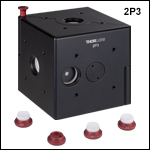
 Zoom
Zoom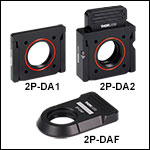
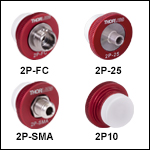
 Ø50 mm Integrating Spheres
Ø50 mm Integrating Spheres